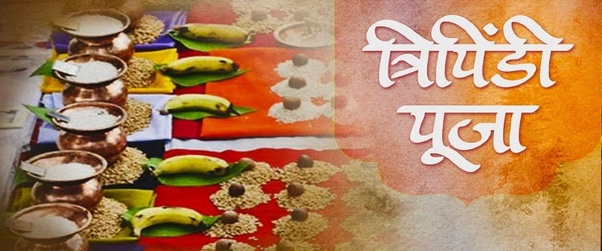Today people adapting to Western culture and forgetting their roots. Our Sanatan culture teaches us how to live our lives without breaking the law of nature. Shraddha is also one of the karm kand that needs to be done to give salvation to our ancestors.
Tripindi Shradha is related to Pitra dosh which is one of the bad doshas in Vedic astrology. To nullify the ill effect of Pitra dosh in your horoscope, Tripindi Shradha needs to be performed.

In the rich tapestry of Hindu rituals and ceremonies, Tripindi Shradha holds a unique and profound place. This ancient tradition, rooted in the belief of honoring departed souls, is a solemn and intricate rite observed by devout Hindus. The term “Tripindi” is derived from two Sanskrit words: ‘Tri,’ meaning three, and ‘Pinda,’ referring to a rice ball offered to ancestors. Together, Tripindi Shradha is a ritualistic observance that involves the offering of three symbolic rice balls to appease and provide solace to the departed souls, particularly those who may be lingering in an unresolved state.
Historical Context
The origins of Tripindi Shradha can be traced back to ancient Hindu scriptures, with references found in texts such as the Garuda Purana and the Markandeya Purana. These scriptures outline the significance of performing rituals to ensure the well-being of ancestors and their peaceful transition to the afterlife. According to Hindu cosmology, the souls of the departed are believed to linger in an intermediate state between death and rebirth, and Tripindi Shradha is performed to assist these souls in finding peace and liberation.
The Ritualistic Process
Tripindi Shradha is a complex ritual that involves several steps, each laden with symbolism and meaning. The ceremony is typically performed by qualified priests, ensuring that the rituals are carried out with precision and adherence to tradition. The key components of Tripindi Shradha include:
- Preparation of Pinda: The ritual begins with the preparation of three Pindas or rice balls. These balls represent the body, mind, and soul of the departed soul. The use of rice symbolizes purity and fertility, essential elements in Hindu rituals.
- Tarpana: Before the actual Tripindi Shradha, a ceremony called Tarpana is performed. This involves offering libations of water mixed with sesame seeds and black sesame seeds to the departed souls. The act of Tarpana is believed to quench the thirst of the deceased and provide them with spiritual nourishment.
- Offerings to Ancestors: The main aspect of Tripindi Shradha involves the offering of three Pindas to appease the three generations of ancestors – father, grandfather, and great-grandfather. The Pindas are placed on a specific triangular platform made of kusha grass, symbolizing the sacred trinity of Brahma, Vishnu, and Shiva.
- Mantras and Prayers: Throughout the ritual, priests chant Vedic mantras and prayers, invoking the blessings of deities and seeking divine intervention for the departed souls. The recitation of sacred verses is considered essential in ensuring the effectiveness of the ritual.
- Food Offering: Alongside the Pindas, offerings of food, water, and other items are presented to the ancestors. The belief is that these offerings sustain the departed souls on their journey to the afterlife.
Significance of Tripindi Shradha
The significance of Tripindi Shradha lies in its role in mitigating the potential negative consequences of unresolved ancestral issues. According to Hindu beliefs, the souls of ancestors who have not found peace may adversely affect the living family members. Tripindi Shradha is performed to address these concerns and ensure the well-being of both the living and the deceased.
- Resolving Ancestral Issues: It is believed that some departed souls may face challenges in the afterlife due to unfulfilled desires, unresolved issues, or the lack of proper funeral rites. Tripindi Shradha is seen as a means to address these concerns and provide the necessary support for the soul’s journey.
- Easing the Transition: The ritual is thought to assist the departed souls in their transition from the material world to the spiritual realm. By offering prayers and performing the prescribed ceremonies, the living seek to facilitate a smoother passage for their ancestors.
- Generational Connection: Tripindi Shradha emphasizes the connection between generations and the continuity of family bonds. By honoring ancestors from three generations, the ritual reinforces the idea of familial unity and the interdependence of past, present, and future.
- Karmic Balance: Hinduism places a significant emphasis on the concept of karma – the idea that actions in one’s lifetime have consequences in the next. Tripindi Shradha is seen as a way to balance the karmic account of the departed souls, ensuring that any negative karmic imprints are mitigated.
Challenges and Contemporary Relevance
While Tripindi Shradha has deep-rooted significance in Hindu tradition, its practice has faced some challenges in contemporary times. Modern lifestyles, geographical dispersion of families, and evolving beliefs have led to a gradual decline in the observance of elaborate ancestral rituals. Some individuals and families may find it challenging to adhere to the prescribed rituals due to various reasons, including time constraints and a shift in religious practices.
However, efforts are being made to adapt Tripindi Shradha to contemporary sensibilities without compromising its essence. Some families choose to perform simplified versions of the ritual, incorporating the essential elements while accommodating the constraints of a busy lifestyle. Additionally, the role of qualified priests in guiding families through the ritual has become more pronounced, ensuring that the sanctity and authenticity of Tripindi Shradha are maintained.
Conclusion
Tripindi Shradha stands as a testament to the enduring spiritual and cultural traditions within Hinduism. This ritual, with its intricate ceremonies and profound symbolism, reflects the deep-rooted belief in the interconnectedness of past and present, the material and spiritual worlds. While facing challenges in the contemporary world, Tripindi Shradha continues to be a meaningful and relevant practice for those seeking to honor their ancestors, resolve ancestral issues, and uphold the spiritual legacy passed down through generations. In its essence, Tripindi Shradha embodies the timeless pursuit of harmony between the living and the departed, bridging the realms of the seen and the unseen in the tapestry of Hindu spirituality.


